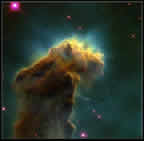 At first glance, the term "Interstellar Medium" may seem a little intimidating. It does not have to be, however. As with any difficult term, it helps to break the word up to see where it comes from:
At first glance, the term "Interstellar Medium" may seem a little intimidating. It does not have to be, however. As with any difficult term, it helps to break the word up to see where it comes from:
First, let's look at the word "Interstellar." It has two main parts: the prefix "inter-" and the ending "-stellar." The prefix inter- is defined as among, between, or amid. The word stellar means of or pertaining to stars or full of stars. If the two are put together, we come up with the definition of interstellar as being "between or among the stars."
Second, we look at the word medium. A medium is something that lies in the middle, or between other things. A medium is also defined as a substance through which an effect is transmitted from one thing to another: when you speak, the waves of sound are carried by the air, so the air is the medium though which sound travels.
Putting the definitions for both words together, we can get a definition for the term "Interstellar Medium." Quite simply, the interstellar medium is the material which is found between the stars. The interstellar medium has an extremely low density, lower than that of the best vacuum created on Earth. (For comparison, the air that we breathe contains 30,000,000,000,000,000,000 (3x1019) molecules in every cubic centimeter, an area about the size of the tip of a finger; while the interstellar gas around our solar system contains only one atom in ten (10) cubic centimeters.) It is mainly made up of gas with some dust. The gas is mostly hydrogen, with a little helium, and small amounts of heavier elements. The dust particles are extremely small -- their size being about the wavelength of blue light -- and consist of silicates, carbon, ice, and/or iron compounds.